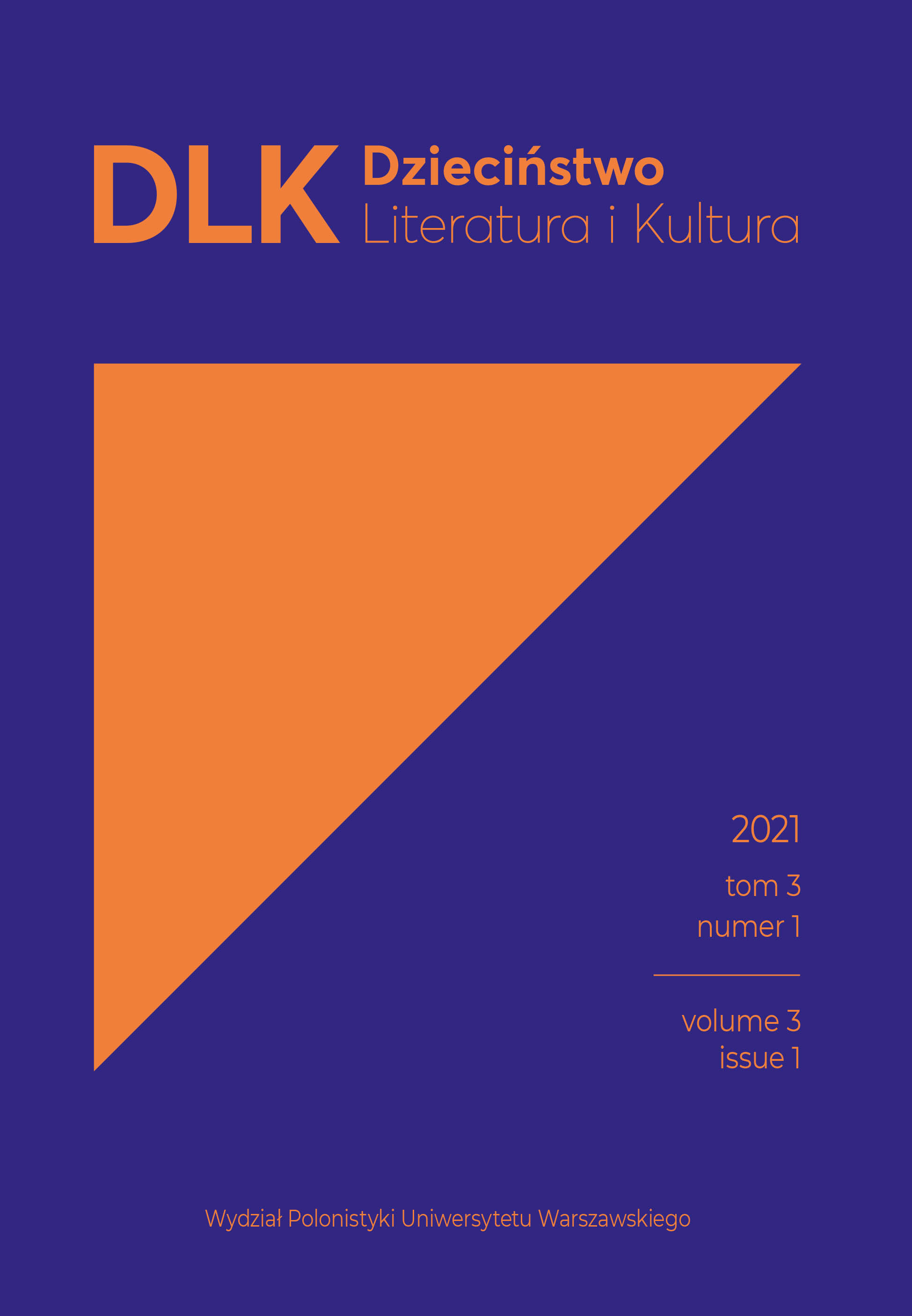Diverse Representations of Success in Asian Children’s Texts
Chen, S.-W. S., & Lau, S. W. (Eds.). (2022). Representations of children and success in Asia: Dream chasers. Routledge.
Abstract
This review article argues that the volume titled Representations of Children and Success in Asia: Dream Chasers, edited by Shih-Wen Sue Chen and Sin Wen Lau (2022), is an invaluable contribution to English-language critical discourse on children’s literature and culture in relation to Asian and non-English language texts. The monograph analyses a broad range of primary texts from Asia, offering a comprehensive introduction to diverse Asian cultural contexts. The chapters address various critical issues, such as questioning rigid standards of educational success, negotiating identities, and becoming a moral being in society. The engaging selection of primary texts and the critical insights presented in the volume may serve as a contribution to further discussions.
Keywords
Asia; Asian children's texts; non-English texts; success in Asia
References
Asialink. (2018). China’s economy. Asialink Business. Retrieved July 5, 2024, from
https://asialinkbusiness.com.au/china/getting-started-in-china/chinas-economy?doNothing=1.
Beauvais, C. (2015). The mighty child. John Benjamins.
Bi, L., Fang, X. (2024). Changing representations of family images in Chinese children’s books of the past century. In B. Wilson & S. A. Osman (Eds.), The Asian family in literature and film: Asia-Pacific and literature in English (pp. 397–420). Palgrave Macmillan.
Chen, I. Y.-Y. (2013). Nation as home? A new quest for Taiwanese Aboriginal literature. In K. Kelen & B. Sundmark (Eds.), The nation in children’s literature: Nations of childhood. Routledge.
Chen, S.-W. (2013). Representations of China in British children’s fiction, 1851–1911. Ashgate.
Chen, S.-W. S., & Lau, S. W. (2020, June 16). CFP: Dream-chasers: Children and success in Asia. IRSCL. Retrieved July 12, 2024, from https://www.irscl.org/irsclnews/1350.
Chen, S.-W. S., & Lau, S. W. (2022a). Disappearing girls: Gendered success and the reproduction of the Singapore family in Jack Neo’s films. In S.-W. S. Chen & S. W. Lau (Eds.), Representations of children and success in Asia: Dream chasers (pp. 98–110). Routledge.
Chen, S.-W. S., & Lau, S. W. (2022b). Dreams of success: Young people, agency, values, and citizenship in Asia. In S.-W. S. Chen & S. W. Lau (Eds.), Representations of children and success in Asia: Dream chasers (pp. 1–16). Routledge.
Chen, S.-W. S., & Lau, S. W. (Eds.). (2022c). Representations of children and success in Asia: Dream chasers. Routledge.
ChinaPower. (2016, February 11). Is the Renminbi undervalued or overvalued? Retrieved July 12, 2024, from https://chinapower.csis.org/renminbi-undervalued/.
Clement, L. D., & Jamali, L. (2015). Global perspectives on death in children’s literature. Routledge.
Dou, M. (2024). Childist rebellion: Rethinking family in the transmedia storytelling of The Bad Kids. In B. Wilson & S. A. Osman (Eds.), The Asian family in literature and film: Asia-Pacific and literature in English (pp. 487–514). Palgrave Macmillan.
Druker, E., Sundmark, B., Warnqvist, Å., & Österlund, M. (Eds.). (2021). Silence and silencing in children’s literature. Makadam.
Earl, C. (2022). Cultivating dreams: Becoming middle-class and affluent in globalising urban Vietnam. In S.-W. S. Chen & S. W. Lau (Eds.), Representations of children and success in Asia: Dream chasers (pp. 212–232). Routledge.
Fairbank, J. K., & MacFarquhar, R. (1995). The Cambridge history of China, vol. 14: The People’s Republic, part 1, the emergence of revolutionary China, 1949–1965. Cambridge. Gangopadhyay, G. (2013). “Our motherland”: Mapping an identity in Bengali children’s literature. In K. Kelen & B. Sundmark (Eds.), The nation in children’s literature: Nations of childhood (pp. 139–157). Routledge.
Ghosh, S. (2022). The grace in fallings: Reading failure as success in SKY Castle and Assassination Classroom. In S.-W. S. Chen & S. W. Lau (Eds.), Representations of children and success in Asia: Dream chasers (pp. 19–35). Routledge.
Goldman Sachs. (2023, July 26). China’s currency rises in cross-border trade but remains limited globally. Retrieved July 24, 2024, from https://www.goldmansachs.com/intelligence/pages/chinas-currency-rises-in-cross-border-trade-but-remains-limited-globally.html.
Goswami, S. (2012). Colonial India in children’s literature. Routledge.
Graff, J. M. & Yeom, E. Y. (2022). Semiotic representations of success in English-language picturebooks for young Korean children. In S.-W. S. Chen & S. W. Lau (Eds.), Representations of children and success in Asia: Dream chasers (pp. 233–255). Routledge.
Gubar, M. (2016). The Hermeneutics of recuperation: What a kinship-model approach to children’s agency could do for children’s literature and childhood studies. Jeunesse: Young People, Texts, Cultures, 8(1), 291–310. https://doi.org/10.1353/jeu.2016.0015.
Izumi, K. (2022). Saviors of the world: Impersonality and success in Shinkai Makoto’s animated films. In S.-W. S. Chen & S. W. Lau (Eds.), Representations of children and success in Asia: Dream chasers (pp. 200–211). Routledge.
Kelen, K., & Sundmark, B. (2016). Child autonomy and child governance in children’s literature: Where children rule. Routledge.
Kelen, K., Sundmark, B. (Eds.). (2013). The nation in children’s literature: Nations of childhood. Routledge.
Kilpatrick, H., & Muta, O. (2013). Deconstructions of the (Japanese) nation-state in Uehashi Nahoko’s Moribito (Guardian) series. In K. Kelen & B. Sundmark (Eds.), The nation in children’s literature: Nations of childhood (pp. 81–96). Routledge.
Kim, Y. (2017). Routledge handbook of Korean culture and society. Routledge.
Kuchibhotla, S. (2022). Hope, oppression, and the Indian urban poor: Portrayals of success in Trash! and Dear Mrs. Naidu. In S.-W. S. Chen & S. W. Lau (Eds.), Representations of children and success in Asia: Dream chasers (pp. 85–97). Routledge.
Lee, S.-A., & Stephens, J. (2013). “The ghost remembers only what it wants to”: Traumas of girlhood as a metonym for the nation in the South Korean whispering corridors (Yeogo goedam) series. In K. Kelen & B. Sundmark (Eds.), The nation in children’s literature: Nations of childhood (pp. 97–110). Routledge.
Moore, C. A. (1992). The Japanese mind: Essentials of Japanese philosophy and culture. University of Hawaii Press.
Mukhopadhyay, U. (2015). From ultimate punishment to heroic sacrifice, and after: Representations of death in Bengali children’s literature from the colonial era. In L. D. Clement & L. Jamali (Eds.), Global perspectives on death in children’s literature (pp. 101–114). Routledge.
Nafisah, N. (2022). Reaching for the stars: Identity and success in three Indonesian children’s films. In S.-W. S. Chen & S. W. Lau (Eds.), Representations of children and success in Asia: Dream chasers (pp. 132–147). Routledge.
Nelson, C., & Morris, R. (2014). Representing children in Chinese and U.S. children’s literature. Routledge.
Nikolajeva, M. (2009). Power, voice and subjectivity in literature for young readers. Routledge.
Nodelman, P. (2008). The hidden adult: Defining children’s literature. Johns Hopkins University Press.
Ren, Y. (2022). To be red: Child propagandist and their success in the Cultural Revolution. In S.-W. S. Chen & S. W. Lau (Eds.), Representations of children and success in Asia: Dream chasers (pp. 113–131). Routledge.
Said, E. (1978). Orientalism. Vintage.
Stephens, J. (2012). Subjectivity in Asian children’s literature and film: Global theories and implications. Routledge.
Superle, M. (2011). Contemporary English-language Indian children’s literature. Routledge.
Tan, F., & Nelson, C. (2022). Youth ecoagency in two Chinese science fiction films on environmental disasters. In S.-W. S. Chen & S. W. Lau (Eds.), Representations of children and success in Asia: Dream chasers (pp. 183–199). Routledge.
Tang, A. & Hsieh, I. H. (2022). Messages of “success” in popular Taiwanese children’s books. In S.-W. S. Chen & S. W. Lau (Eds.), Representations of children and success in Asia: Dream chasers (pp. 164–180). Routledge.
Wibawa, S. (2022). Becoming Indonesian: Political constructions of successful children in Aku Ingin Menciummu Sekali Saja and Denias Senandung di Atas Awan. In S.-W. S. Chen & S. W. Lau (Eds.), Representations of children and success in Asia: Dream chasers (pp. 148–163). Routledge.
Wu, A. M-Y. (2024). Taiwanese picturebooks and the changing images of the family in the age of globalisation. In B. Wilson & S. A. Osman (Eds.) The Asian family in literature and film: Asia-Pacific and literature in English (pp. 469–485). Palgrave Macmillan.
Yanilla Aquino, L. F. (2024). The representation of the Filipino family in Philippine children’s stories from 1990 to 2022. In B. Wilson & S. A. Osman (Eds.) The Asian family in literature and film: Asia-Pacific and literature in English (pp. 265–283). Palgrave Macmillan.
Yokota, J. (2016). Finding the spaces within: Picture books in which children (can) enter and have agency. In K. Kelen & B. Sundmark (Eds.), Child autonomy and child governance in children’s literature. Routledge.
Yung, F. D. (2021). The silencing of children’s literature publishing in Hong Kong. In E. Druker, B. Sundmark, Å. Warnqvist, & M. Österlund (Eds.), Silence and silencing in children’s literature. Makadam.
Zou, Y. (2022). Representations of money and success in contemporary Chinese children’s literature. In S.-W. S. Chen & S. W. Lau (Eds.), Representations of children and success in Asia: Dream chasers (pp. 71–84). Routledge.
Uniwersytet Tsukuba Japan
https://orcid.org/0000-0002-0392-5397
Faye Dorcas Yung Schwendeman – PhD, works at the Institute of Humanities and Social Sciences, University of Tsukuba (Japan). Her research interests include children’s literature criticism, cultural representations in children’s literature, and 20th-century East Asian children’s magazines. Contact: faye.schwendeman.ft@u.tsukuba.ac.jp.

This work is licensed under a Creative Commons Attribution 4.0 International License.
Open Access Policy
All articles presented on the pages of ”Dzieciństwo. Literatura i Kultura” are published in open access under a Creative Commons license - Attribution 4.0 International (CC BY 4.0). It means that:
- they can be made available and quoted under the condition of explicit and clear indication of the author/authors of the referenced text;
- you cannot use legal or technological means that would limit others in using the text under the terms of the license.
More information: https://creativecommons.org/licenses/by/4.0/





